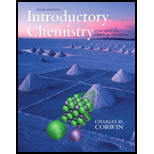
(a)
Interpretation:
Among
Concept introduction:
The vapor pressure is defined as the pressure exerted by the vapor of the substances that are in equilibrium with the condensed phase at a given temperature. The temperature at which the atmospheric pressure is equal to the vapor pressure is known as the boiling point.
(b)
Interpretation:
Among
Concept introduction:
The vapor pressure is defined as the pressure exerted by the vapor of the substances that are in equilibrium with the condensed phase at a given temperature. The temperature at which the atmospheric pressure is equal to the vapor pressure is known as the boiling point.
Want to see the full answer?
Check out a sample textbook solution
Chapter 19 Solutions
Introductory Chemistry: Concepts And Critical Thinking, Books A La Carte Edition (8th Edition)
- Maleic acid and fumaric acid are the cis- and trans- isomers, respectively, of C2H2(COOH)2, a dicarboxylic acid. Draw and label their structures.arrow_forwardOf the alcohols with the molecular formula C4H9OH, which has the highest boiling point?arrow_forwardYour roommate, a chemistry major, claims to have synthesized the compound CH5 in the lab. Why is that not possible?arrow_forward
- 1-Propylamine, propan-1-ol, acetic acid, and butane have about the same molar masses. Which would you expect to have the (a) highest boiling point, (b) lowest boiling point, (c) least solubility in water, and (d) least chemical reactivity? Have each member of your group chose a part to answer, andthen discuss with each other why those answers were chosen.arrow_forward3. Which compound is likely to have a higher boiling point? Whya. A polar compound without O-H or N-H bonds, or a polar compound with O-H or N-H bondsb. CH3CH2CH2OH or CH3(CH2)4OH4. Compare boiling points and solubilities in water for each pair of compounds. Explain a. Ammonia, NH3 and methane, CH4b. Pentanol, C5H11OH, and pentane, C5H12arrow_forwarddraw the structure of all monobromo derivatives of pentane, C5H11Br, which contain a 4 carbon chainarrow_forward
- Propanal and propanone have the same molecular formula, C3H6O, therefore they are?arrow_forwardWhich one of the following two compounds has the stronger IMF - and therefore the higher boiling point? ClF5 PF5arrow_forwardc) Draw one possible structure with molecular formula C6H12 that has two tertiary carbon.d) Arrange the following compounds in increasing order of melting point.Hexane, 3-methylhexane, 3-ethylhexane, 2,3-dimethylpentanearrow_forward
- Draw Lewis structures for the following compounds, andpredict which member of each pair will form hydrogen bonds:(a) NH₃ or AsH₃(b) CH₄ or H₂Oarrow_forwardWhat is the bond order of the C-O bonds in diethyl ether?arrow_forwardWhich of the following structural features could be found in a compound with formula C7H12?arrow_forward
 Chemistry: Principles and PracticeChemistryISBN:9780534420123Author:Daniel L. Reger, Scott R. Goode, David W. Ball, Edward MercerPublisher:Cengage Learning
Chemistry: Principles and PracticeChemistryISBN:9780534420123Author:Daniel L. Reger, Scott R. Goode, David W. Ball, Edward MercerPublisher:Cengage Learning Organic ChemistryChemistryISBN:9781305580350Author:William H. Brown, Brent L. Iverson, Eric Anslyn, Christopher S. FootePublisher:Cengage Learning
Organic ChemistryChemistryISBN:9781305580350Author:William H. Brown, Brent L. Iverson, Eric Anslyn, Christopher S. FootePublisher:Cengage Learning Chemistry: The Molecular ScienceChemistryISBN:9781285199047Author:John W. Moore, Conrad L. StanitskiPublisher:Cengage Learning
Chemistry: The Molecular ScienceChemistryISBN:9781285199047Author:John W. Moore, Conrad L. StanitskiPublisher:Cengage Learning Introductory Chemistry: A FoundationChemistryISBN:9781337399425Author:Steven S. Zumdahl, Donald J. DeCostePublisher:Cengage Learning
Introductory Chemistry: A FoundationChemistryISBN:9781337399425Author:Steven S. Zumdahl, Donald J. DeCostePublisher:Cengage Learning Chemistry: Principles and ReactionsChemistryISBN:9781305079373Author:William L. Masterton, Cecile N. HurleyPublisher:Cengage Learning
Chemistry: Principles and ReactionsChemistryISBN:9781305079373Author:William L. Masterton, Cecile N. HurleyPublisher:Cengage Learning




